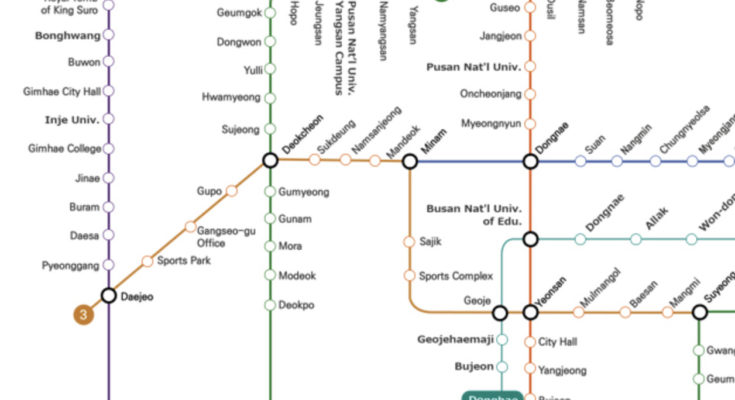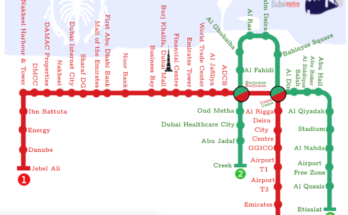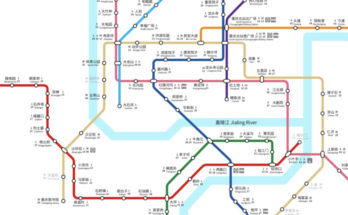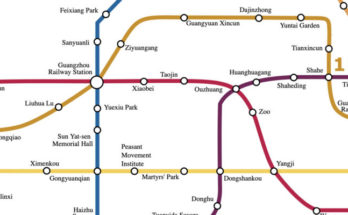Busan Metro has a total length of 109.5 km, 4 lines and 107 stations.
It’s managed by the Busan Transportation Corporation. In addition there’s a light rail line connecting Busan with Gimhae, but is managed by a private entity. This fifth line has a length of 23,9kms and adds 21 stations to the system. The 5 lines together form a network with 133.4 kilometers of routes and 128 stations.
Busan (or Pusan) is the second largest city in South Korea. Its population is approximately 3.6 million inhabitants.
To move this huge number of people every day, Busan has a municipal bus network with 134 routes connecting with the metro line, a railroad (with high speed lines) connecting to nearby cities (Seoul, Dajeon, …) and the metro system.
Busan Metro has a total length of 109.5 km, 4 lines and 107 stations.
It’s managed by the Busan Transportation Corporation. In addition there’s a light rail line
connecting Busan with Gimhae, but is managed by a private entity. This fifth line has a length of 23,9kms
and adds 21 stations to the system. The 5 lines together form a network with 133.4 kilometers of routes and 128 stations.
- Lines 5 ( incl. Gimhae LRT BGL)
- Stations: 107 + 21 (metro + LRT BGL)
- Passengers/day: 890K
- Opening: July 19, 1985
- Operator: Busan Transportation Corporation B&G Metro
- Length: 109,5 km + 23,9 ( metro + LRT BGL)
Lines and stations
Line 1 ( orange line )
It has a total length of 32,5kms and 34 stations. It crosses the city from Sinpyeoung in the north to Nopo Dong in the south. A full ride from end to end takes about 1 hour. Desing of line 1 began in 79 and it started to be operational in 1985 with the corridor Nopo-Dong – Beomnaegol (16.2 kms of route). Then there were 3 more extensions: in 1987, 5,4 kms were added along Beomnaegol – Jungang-dong, 4.5 kms in 1990 joining Jungang-dong with Seodaesin-dong and finally 6.4 kms in the path of Seodaesin-dong to Sinpyeong. Currently there is a new extension being built to connect to the Saha-gu area.
The 34 stations are: Sinpyeong, Hadan, Dangni, Saha, Goejeong, Daeti, Seodaeshin-dong, Dongdaeshin-dong, Toseong-dong, Jagalchi, Nampo-dong, Jungang-dong, Busan Station, Choryang-dong, Busanjin, Jwacheon-dong, Beomil-dong, Beomnaegol, Seomyeon, Bujeon-dong, Yangjeong, Municipality, Yeonsan-dong, Busan National University of Education, Dongnae, Myeongnyun-dong, Oncheonjang, Pusan National University, Jangjeon-dong, Guseo-dong, Dusil, Namsan-dong, Beomeosa and Nopo-dong.
Line 2 (green line)
Line 2 crosses Busan from Hopo in the east to Jangsan in the west.
Section Hopo – Seomyeon is operational since 1991. It also has had several extensions. Currently Busan Metro Line 2 has 44.5 kilometers and 39 stations. The first extension in 1999 was the section Hopo to Seomyeon which added 21.7 km. In 2001, Seomyeon – Geumnyeonsan added another 7.7 kms. In 2002, section Geumnyeonsan – Gwangan added half a mile (1km). In August 2002 this line was expanded 7.7 kms with Gwangan to Jangsan section. In 2007 from Hopo to Yangsan other 7,2kms. Finally in 2009 the line reached Busan National University Yangsan.
Stations: Jangsan, Jung-dong, Haeundae, Dongbaek, Museum of Modern Art in Busan, Centum, Milak, Suyeong, Gwangan, Geumnyeonsan, Namcheon, Kyungsung University and Pukyong National University, Daeyeon, Motgol, Jigegol, Munhyeon, Munjeon, Jeonpo, Seomyeon, Buam, Gaya, Dongeui University, Gaegeum, Naengjeong, Jurye, Gamjeona, Sasang, Deokpo, Modeok, Mora, guṇam, Gumyeong, Deokcheon, Sujeong, Hwamyeong, Yulli, Dongwon, Geumgok, Hopo
Line 3 (golden line)
Line 3 became operational in November 2005. It links Daejeo to Suyeong. 18.1 km and 16 stations.
Stations: Suyeong, Mangmi, Baesan, Mulmangol, Yeonsan-dong, Geoje, Sports Complex, Sajik, Minam, Mandeok, Namsanjeong, Sukdeung, Deokcheon, Gupo, Gangseo-gu Office, Sports Park
Line 4 (blue line)
It’s 12.7 kms length line along 14 stations linking Anpyeong to Minam. It was to be a branch of line 3
but finally opened in 2011 as a new line.
Stations: Minam, Dongnae, Suan, Nakmin, Chungnyeolsa, Myeongjang, Seodong, Geumsa, Banyeo Agricultural Market, Seokdae, Youngsan University, Dong-Pusan College, Gochon, Anpyeong
Line 5 (purple line)
It is a light rail line linking Busan to Gimhae. It extends the system 24kms and 21 stations.
Terminal stations are Sasang and Samgye. This line is operated by a private entity.
Schedule
Metro hours are from 05:00 to 00:30, everyday.
Rates and tickets
The system is divided into two tariff areas. Rates are 1,300 won to any destination within a distance of 10kms (first zone) and 1500 won for others (second zone).
There are also metro passes as Hanaro Card with Discounts of 10% for adults and 20% for young people between 13 and 18 years old.
These passes are also valid for the bus.
Busan Metro Map
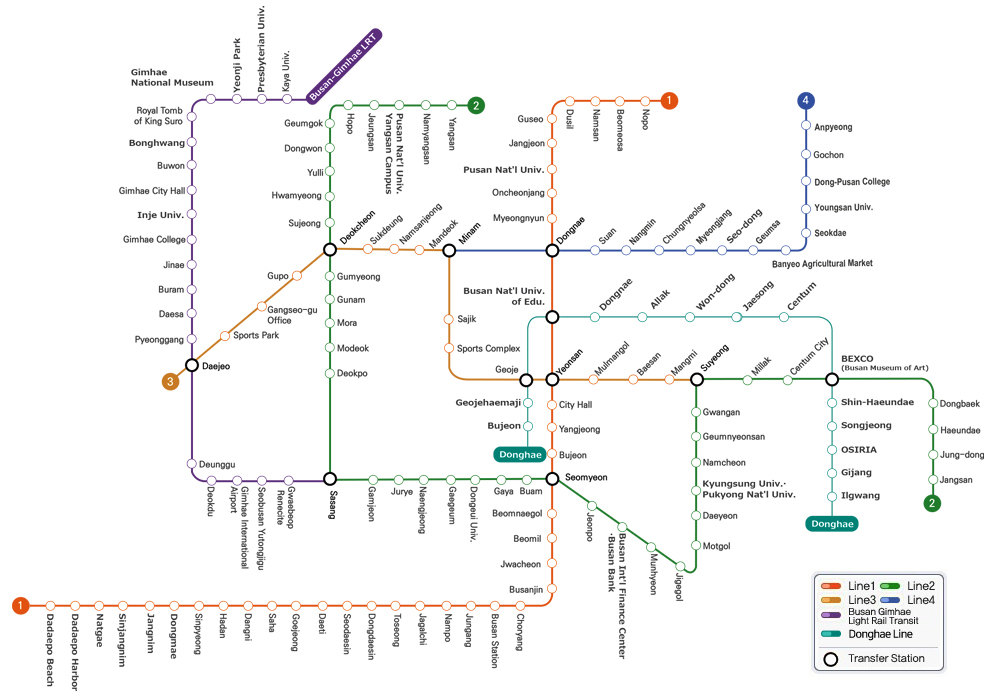
Map via https://english.busan.go.kr/
Interesting facts
Korean, English, Japanese and Mandarin languages are used someway in Busan Metro.
Connection to the airport
Gimhae International Airport is located west of Busan.
It can be reached via a subway, bus and taxi.
This post is also available in: German
